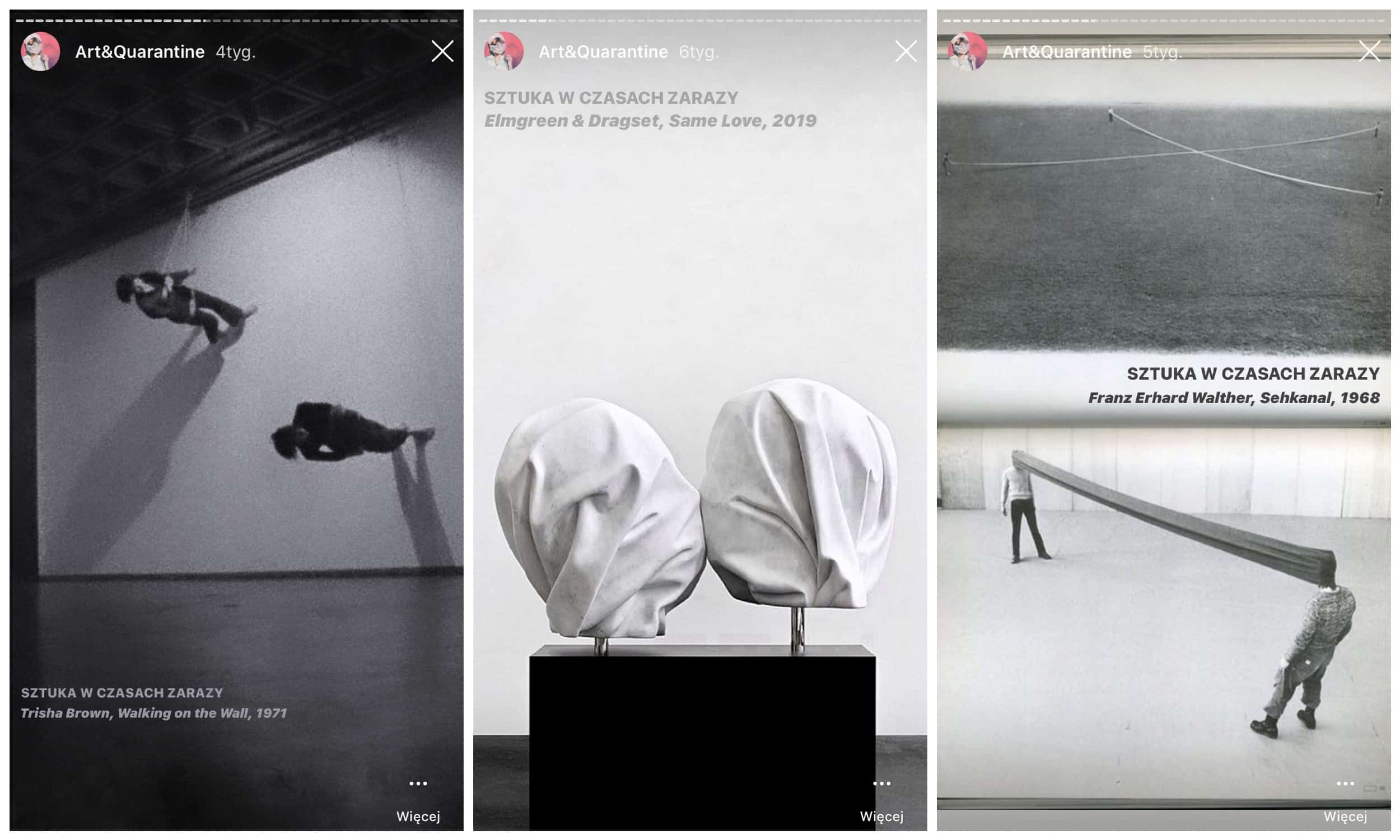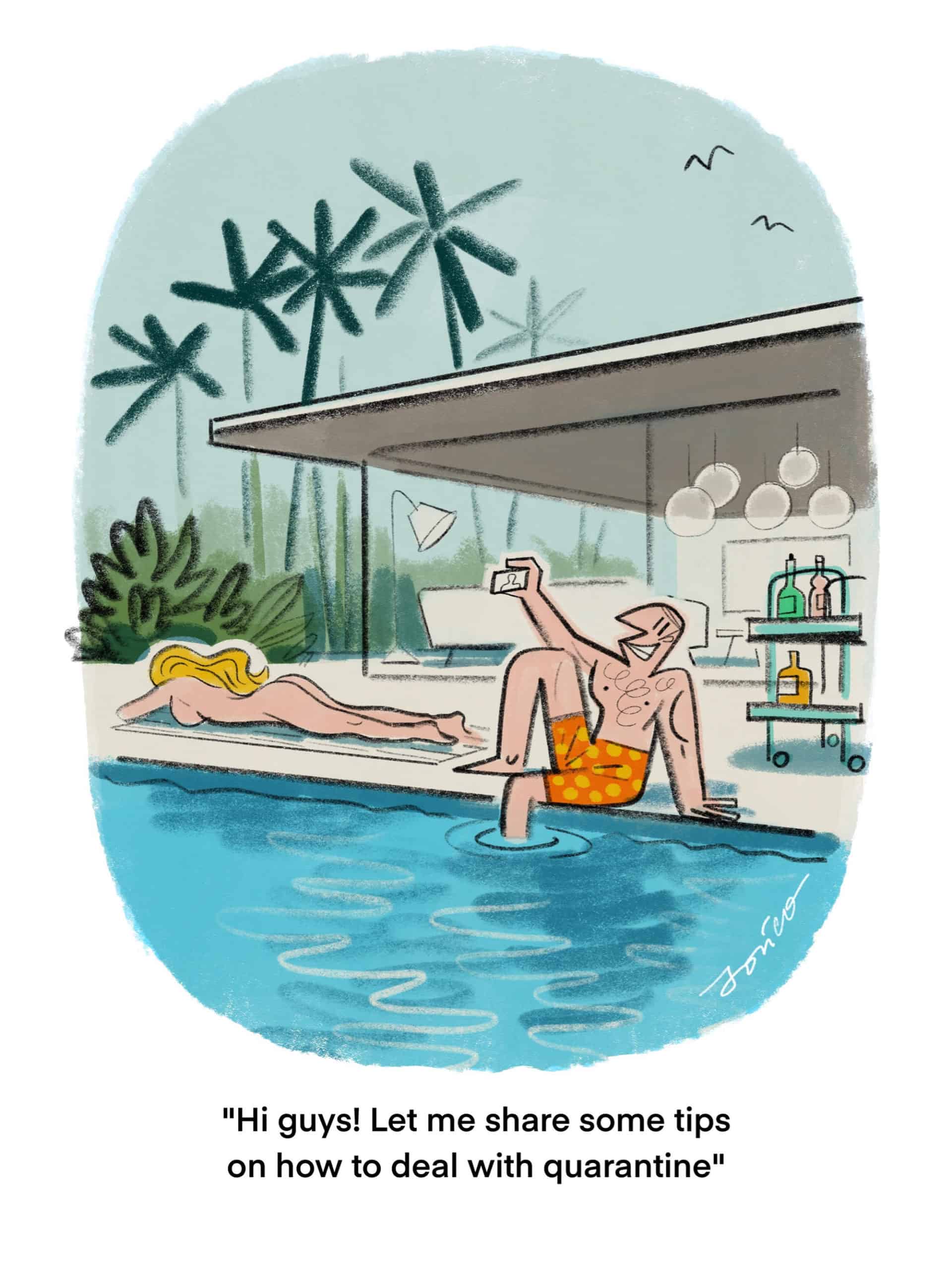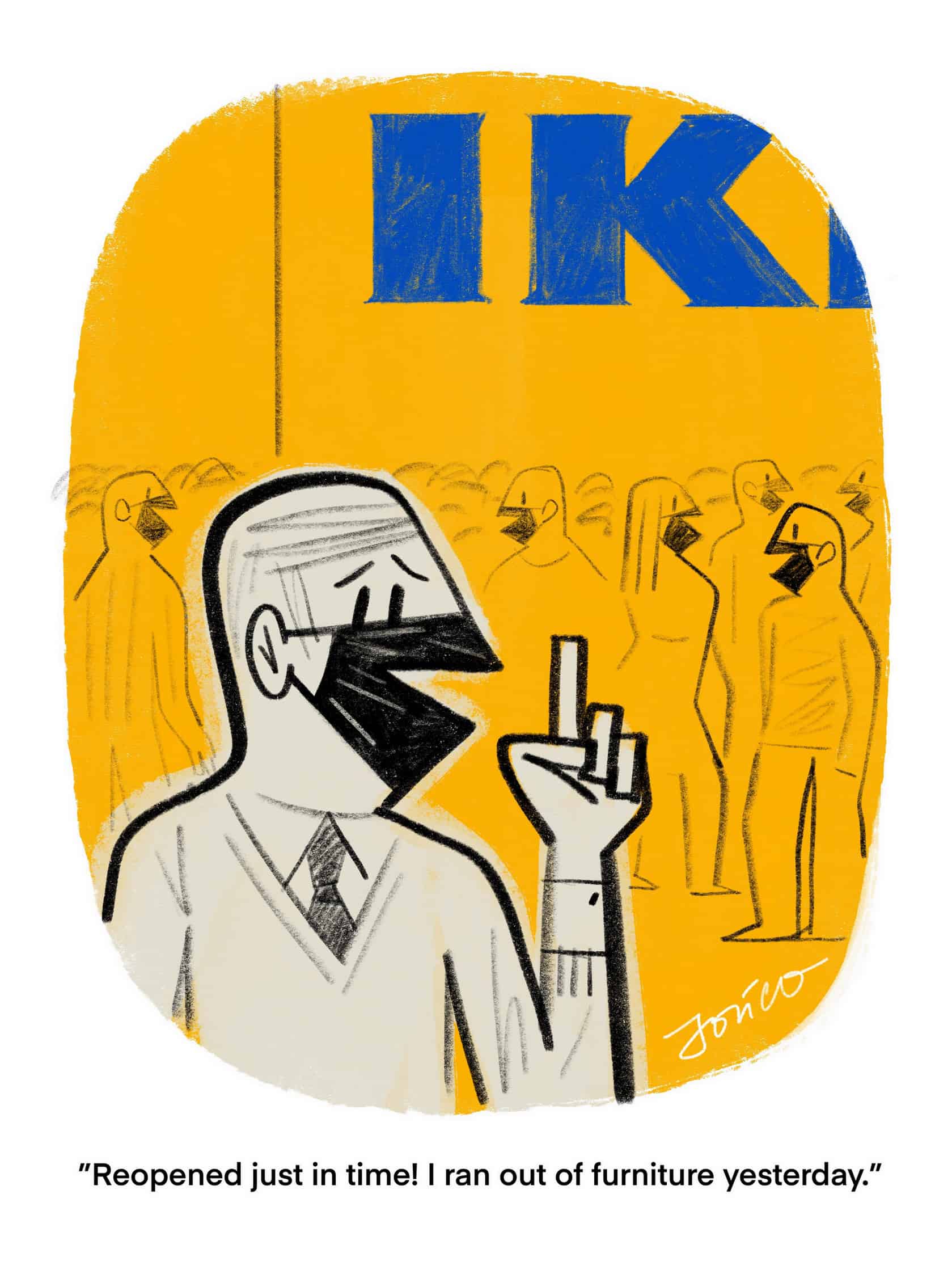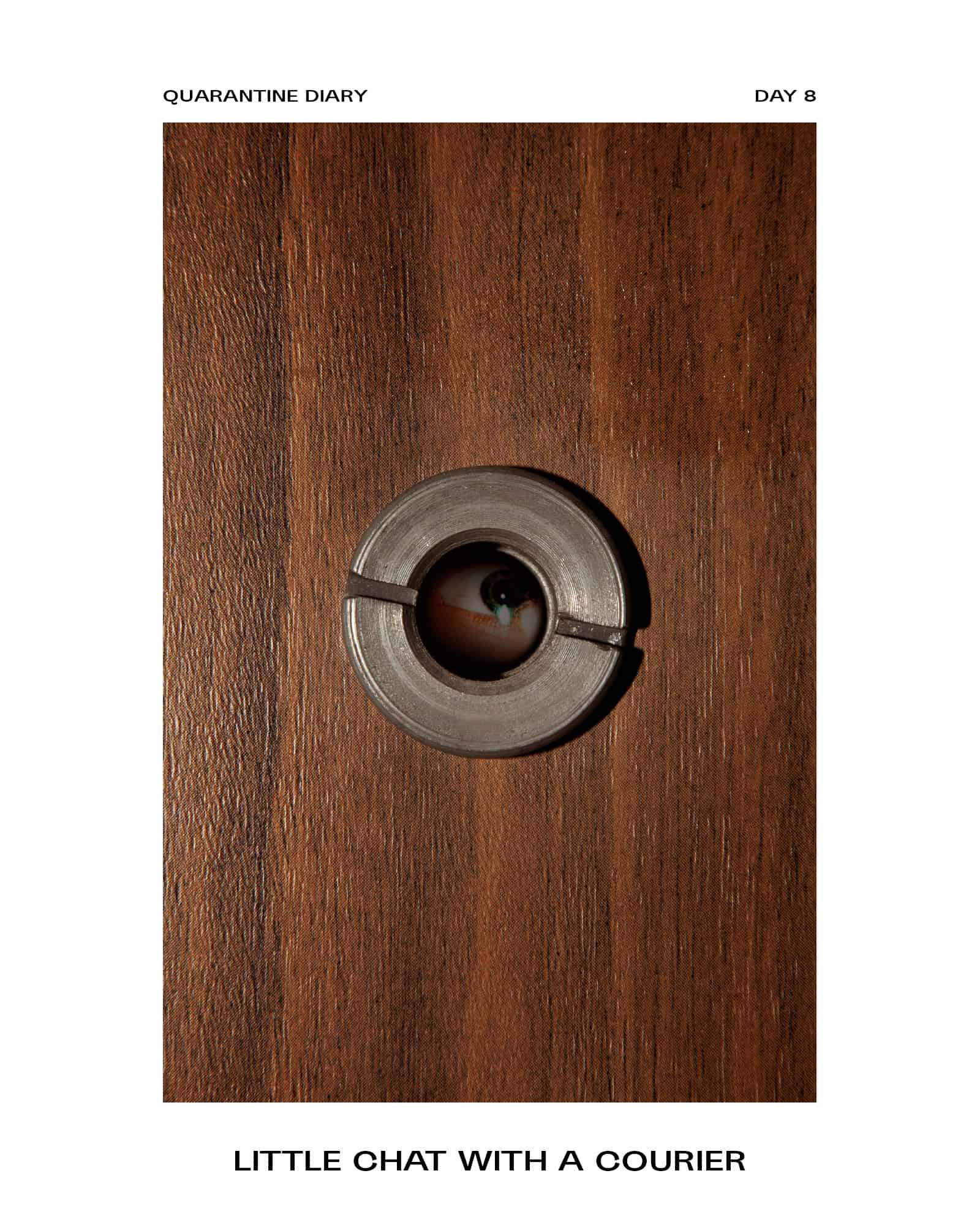On Friday, the unlucky March 13th, I voluntarily underwent a domestic isolation, yet still unaware of the escalation of the coronavirus pandemic. However, I foreknew the unpleasantness of a long-lasting home confinement. When I virtually looked around (since life moved to the Internet), it turned out that many people saw quarantine as a favourable condition for autodidacticism and self-development. There were also some who shared their knowledge and interests with the “fellow-prisoners” via social media. Since my friend persuaded me to make use of my art historian profession I decided to publish the selected artworks of the 20th and 21st century on Instagram stories. One piece a day. This is how a cycle which I entitled – paraphrasing Gabriel García Márquez – “Art in the Time of Plague” came into being.
At the beginning my Instagram series was supposed to be just an innocent entertainment to kill boredom. With the passing of time, browsing through visual memory transformed into a play with imagery, iconography and connotations. Selecting images brought out their semantic malleability. The works of art were either losing the original sense attributed to them to gain a new one or showing their currentness. By placing art pieces in the context of the pandemic I intentionally vested them with different meanings. I trivialized some while elevating others to an accurate commentary on contemporary reality. I embraced their humorous potential, defeatist or optimistic aura, and quite often fantasized characters.

„Art in the Time of Plague”, Instagram stories @polarhavet (private archives Wojciech Delikta)
A set of epidemic themes and motifs emerged out of the collection of artworks assembled day by day. Sterile, almost antiseptic environments by James Turrell appeared to be synonymous with isolation. The luminous and colorful installations are as visually attractive as oppressive, for you cannot do anything in it but exist. Do not sit, do not touch, do not leave any mark. The Californian minimalist had also imprisoned the viewer in “Soft Cell” (1992) – sort of a sensory deprivation chamber covered entirely with soundproof foam. Tehching Hsieh, on the other hand, had willingly isolated himself in the work “One Year Performance 1978-1979 (Cage Piece)”. The Taiwanese artist spent the whole year behind the bars of a cell built in his atelier. “I shall seal myself in my studio, in solitary confinement inside a cell-room… I shall not converse, read, write, listen to the radio or watch television, until I unseal myself on September 29, 1979” – he wrote in a statement.

„Art in the Time of Plague”, Instagram stories @polarhavet (private archives Wojciech Delikta)
Incarcerated at home as in “Condensation Cube” (1965) by Hans Haacke we could feel like Olympia from Joel-Peter Witkin’s photograph “Sanitarium” (1983) or like Tilda Swinton sleeping in Cornelia Parker’s glass cabinet („The Maybe”, 1995). To fight boredom we sought succour in George Segal’s sculpture of Alice listening to the radio (1970), in Wolfgang Laib zealously sifting pollen or in Gilbert & George’s melodious performance “Singing Sculpture” from 1969. We replaced parties at clubs with a silent disco – similar to that one from “Go-go Dancing Platform” (1991) by Félix González-Torres. Longing for a gym we sympathised with the dejected “Bodybuilder” (1989) by Duane Hanson.

„Art in the Time of Plague”, Instagram stories @polarhavet (private archives Wojciech Delikta)
In home-quarantine circumstances being productive often competed with sluggishness that falls into madness. Having no idea what to do with oneself, some absurd activities came to mind, like those from Bruce Nauman’s video “Bouncing in the Corner” (1968), Erwin Wurm’s “One Minute Sculpture” or from physically exhausting performance “Drawing Restraint 2” (1988) by Matthew Barney. Every day seemed the same just like each unit in Donald Judd’s minimal objects. A figure of speech “climbing the walls” echoed in Trisha Brown’s choreography “Walking on the Walls” (1971).
After many works of art gravitating around the motive of a concealed face (e.g. Elmgreen & Dragset, “Same Love”, 2019) or a surgical mask (e.g. Richard Prince, “Nurse Elsa”, 2002), I sought solace, so much needed in the time of anxiety. Neither I found it in the œuvre of Franz Erhard Walther that thematizes the lack of intimate closeness and physical distancing, nor in a gravestone of the future “Tomorrow” (2013) by Elmgreen & Dragset. Finally one of John Giorno’s paintings popped up. The context of quarantine gave its verbal content a surprisingly accurate meaning: “It’s not what happens. It’s how you handle it”. Although Giorno’s piece brought some comfort, I decided to end my Instagram cycle. I did it with a mail-art work by Hungarian artist, Gábor Tóth – an enveloped paper card saying: “Sorry, no art today.”
Polish illustrator Paweł Jońca turned out to be a much more assiduous chronicler of pandemic reality than myself. His visual diary simply entitled “Life in Quarantine” became richer with each day and now comprises over a hundred pictures. He posted his first drawing on Instagram on March 16th, so a few days after Poland had closed its borders. It depicts a man on the bus who enjoys the scent of a freshly disinfected vehicle. Since then we can follow Jońca’s commentary expressed in a form of witty drawings that could easily be published in “The New Yorker”.
Paweł Jońca, „Day 16” from the cycle „Life in Quarantine” (courtesy of the artist)
Paweł Jońca, „Day 14” from the cycle „Life in Quarantine” (courtesy of the artist)
Paweł Jońca, „Day 49” from the cycle „Life in Quarantine” (courtesy of the artist)
The association with the famous “The New Yorker” cartoons is not unjustified. Jońca’s line might resemble graphics by Peter Arno or Robert Day and the tradition of American press illustration in the 1950s and 1960s. Even though the characters and scenery in Jońca’s pictures bring to mind the mid-century modern style, he reflects on the contemporary times. It suffices to look at his drawing from day 16 of isolation entitled “Tough life of a Youtuber”. While sitting by the pool at his Californian case-study-house-like villa, the title character is advising his fans on how to deal with quarantine. In another picture called “Job of The Year” we can see three men walking out of the employment agency wearing not only elegant suits in Don Draper’s fashion but also signs saying “We are all going to die” and “The End is near” taking on the role of human billboards.
The formal and technical elegance of Jońca’s drawings is accompanied by a brilliant, tongue-in-cheek humor. The illustrator pokes fun at the pandemic reality: bans and orders, restraints, alterations and longings for the old normal. He mocks people to whom toilet paper is more precious than jewellery and who storm the newly reopened IKEA stores. Instead of travelling the world the characters in his drawings shuttle between kitchen and living room. They sneak out for jogging as it was an urban guerilla and confirm marriage not with a kiss but with distanced hand-waving. The graphic commentary by Paweł Jońca matches both Polish and foreign realities – everywhere, where the COVID-19 epidemic has deranged the status quo ante.
Jońca is creating new drawings every day, since each day brings him a new set of inspiration. “What’s funny is that the first drawing (the guy on a bus) could be the last because it depicts the moment when it all ends and everything is clean and fresh” – says Jońca – “I don’t know when I’ll stop. I’m going to draw… till the end.” He assures us that his Instagram cycle will be transposed onto paper and published as a pandemic diary.
Kamil Kotarba, „Day 1” from the cycle „Quarantine Diary” (courtesy of the artist)
Kamil Kotarba, „Day 8” from the cycle „Quarantine Diary” (courtesy of the artist)
In fact creating images of a lockdown in the form of day-by-day memoirs became a quite popular practice. In compliance with the new law many Polish citizens who came back from abroad to the country had to undergo an obligatory quarantine of 14 days. Kamil Kotarba was among them. The photographer turned the home isolation into an art project. Two weeks of solitary confinement resulted in a series of 14 photographs with captions. One of them “I stopped shaving my beard” can be found under a self-portrait of Kotarba whose entire face is covered with hair. “Little chat with a courier” describes a close-up image of an eye peeking through a door viewer. Under another picture depicting the artist literally levitating above a mat we read: “I practice yoga. I don’t know if I’m doing it right”. All these explicatory captions seem to come in handy. They emphasize not only the wittiness and comical aspect of photographs and photomontages but also their surrealistic bizarreness and dadaistic absurdity. These weird compositions, illuminated with a cool flash light, exist somewhere in an intersection of the esthetics of Ren Hang and Man Ray. Kotarba converted the boring, day-after-day life in quarantine into an extraordinary imagery bedizened with humor.
The visual diaries of domestic isolation demonstrate a new array of topoi, themes and motifs that emerged during the pandemic. Beside face masks and medical gloves it encompasses binge-watching, online shopping hauls, syllogomania proper to hoarders and preppers, hygiene bordering upon germophobia, videochats, avoiding physical contact or distanced hang-outs. It is the iconography of apathy, boredom, frustration, fear, longing, anxiety, uncertainty, giving up, and loneliness. Life in quarantine, observed day by day, seems to have something in common with the five stages of grief introduced by Elisabeth Kübler-Ross: denial, anger, bargaining, depression, and acceptance of state of affairs. Visual artists deal with the negative aspects of isolation by making use of creativity and humor and they are encouraging us to do the same.

Paweł Jońca, „Day 41” from the cycle „Life in Quarantine” (courtesy of the artist)













